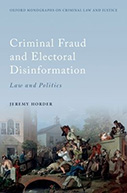Criminal Fraud and Election Disinformation

Author: Jeremy Horder
Publisher: Oxford University Press, 2022. 224 pages.
Reviewer: Jacob Eisler | December 2022
The existential crisis of liberal democracy has been bubbling for more than half a decade, brought to painful intermediate culmination with Brexit and Donald Trump’s election as president. As Western democracies have tottered through these crises, they have faced a uniquely procedural challenge: conflict not only over the substance of governance and leadership (part, when not excessively acrimonious, of any healthy democracy), but over the legitimacy and soundness of the constitutive processes of democratic self-rule itself. This process may have had its first iterations in Donald Trump’s false claims that Barack Obama was not American-born and thus could not run for president, and in the assertion that the Brexit vote was foundationally tainted by Brexiteers’ false claims regarding the financial benefits of leaving the EU. It has had its most dramatic manifestation in the January 6th, 2021 storming of the US capitol by ‘stop the steal’ conspiracy theorists protesting Joe Biden’s victory as obtained through fraudulent manipulation of the voting process.
Subsequently, how to handle false claims in politics is especially urgent and makes Jeremy Horder’s Criminal Fraud and Election Disinformation (hereinafter, CFED) a very timely contribution regarding the intersection of criminal law and democratic process. Horder’s book is a deft cross-jurisdictional examination of how actors—particularly states, but also increasingly influential entities such as social media platforms—should address false claims in political discourse. Horder takes the view that while “electoral participation disinformation”—claims that attempt to spread false information about how an electoral process operates—should be criminalized, “political viewpoint disinformation”—false substantive claims about the political merits and demerits of candidates and positions—should be left unregulated, with falsehoods vetted through the marketplace of ideas (p. 1).
Underlying Horder’s dichotomy is the premise that where false information can be understood as part of a substantive political debate, it is better that the essential engines of democracy—debate, reflection, and decision by the franchise—resolve its falsity. Substantive governmental oversight of substantive political debate threatens to replace open democratic reasoning with state-curated narratives (with potentially troubling path-dependency). Even if falsehood in substantive political debates is morally wrongful, the best way to identify and purge its wrongfulness is liberal dialogic truth-seeking. However, deception regarding the pure technicalities of elections—spreading falsehoods regarding practical participation in elections—undermines the legitimacy of democracy in a way that even liberal democracy cannot tolerate. This is because it disrupts the basic correlation between political outcomes and legitimately understood popular. Likewise, allowing deceptions regarding electoral process to stand contributes little to the substantive advancement of truth. Such electoral participation disinformation can thus be criminalised with significant social benefit and little social cost. This differentiation between misleading dissemination of information that advances false substantive information as opposed to false procedural information is comfortingly and classically liberal. Horder uses it to organize, interrogate, and critique a wide variety of legal measures and practical contexts, from the prospective regulatory overreach of the criminalization of electoral defamation under the Representation of the People Act 1983 to the relatively permissive use of bots on social media (pp. 101, 136–159). The work is also marked by its comparative sweep, as it ranges across jurisdictions: the US, the UK, Germany, Singapore.
Taken as a contribution to an increasingly timely topic, Horder’s approach in CFED offers a sensible way of differentiating between two types of interventions in elections—neither laudable, but one more unequivocally corrosive to popular self-rule—on a basis compatible with liberal democratic autonomy. In particular, Horder advances a “liberal democratic approach” that trusts the people to differentiate true substance from false substance rather than the increasingly prevalent “militant democratic approach” advanced by, for example, Jan-Werner Muller, which argues that a collective understanding of right can justify substantive state limitations of speech (p. 23).
At another level, however, CFED raises more questions than it answers. This is largely because, despite suggesting his work is a contribution to “political theory,” Horder works at the intersection of regulatory doctrine and policy: his book unpacks and defends how a liberal understanding of democracy should inform judicial and legislative decision-making (p. 1). In doing so, Horder explicitly abjures traditional criminal law doctrinal elements and categories—“actus reus, mens rea, and justification and excuse”—to inform norms of legality in the electoral context (p. 14). Rather, Horder determines the appropriate legal treatment of electoral disinformation by whether it is better classified as electoral participation disinformation or political viewpoint disinformation. Ultimately, this distinction only serves as a cipher for the question of whether a given piece of disinformation is an attempt to sway substantive political discourse over questions of (for example) representative merit and good governance or to sway (as in, interdict) practical participation in political discourse.
Horder makes a convincing case that this substantive-versus-procedural intervention in democracy should be used to determine treatment of fraudulent statements as a matter of policy practice. But he does not do much to interrogate either the ardently classical liberalism that underpins his position, or—even more foundationally—tease apart how the building blocks of human social organization and political participation indicate how (and why) to differentiate between political viewpoint and electoral participation disinformation. By declining to do so, CFED becomes closer to a detailed policy or legal reform proposal than Horder seemingly intends. More accurately characterized as a broad-ranging proposal, CFED assumes some morally weighty but contestable premises. Interrogating these premises highlights the need to understand electoral fraud either through foundational political theory (the direction Horder would seemingly prefer, but which requires a great deal more analytic work) or—surprisingly—back towards the deontological morality expressed by traditional criminal law categories.
The first aspect is that Horder’s framework, most relevantly the core distinction between political viewpoint and electoral disinformation, requires a normative theory of democracy. Horder indicates what these commitments are, but this occurs primarily in an incidental manner while he interrogates doctrinal and policy questions. The decision not to articulate these commitments in a systematic, unified manner has two implications. The first is a certain tangential or fragmentary quality to the work as a theoretical contribution—CFED does in fact posit a foundational theory, but it is less clearly stated than it might be. One aspect of this, the Millian root of Horde’s classical liberalism—the idea that substantive political falsehoods should be vetted through open discourse rather than regulation—only receives the briefest passing articulation (pp. 16, 47). Yet Horder’s commitments go far beyond this. For example, in framing the general moral disapprobation of lying, Horder quotes Mark Seidenfeld to assert that the state only legitimately acts when it furthers the “common good” (p. 19). This position—while normatively palatable—is only one understanding of political legitimacy and stands in opposition to power-based understandings of democracy that trace democracy’s legitimacy to its capacity to reconcile competing self-interest of participants (a tradition that can be traced back to Hobbes and has current incarnations in, for example, public choice theory). Similarly, to support the claim that electoral disinformation is uniquely worthy of criminalisation, Horder invokes Chantal Mouffe’s vision of democracy as a practice of bounded agonism (p. 38). In short, Horder draws from whatever political theories best suit his needs for a particular piece of analysis in the text.
One immediate consequence of this is it is not entirely clear what Horder’s basic principles are and thus it is difficult—or at least requires significant reconstruction—to see the foundations upon which his driving substance-versus-process distinction rests. At least in some sense his theory of democracy appears to be shot through with a tension. On the one hand, he appears to advance a distinctly civic republican conception of democracy in which governance is legitimized by and should possess the spirit of a shared public endeavour. Yet on the other hand, Horder shows a far more individualist bent, indicating fundamental skepticism regarding the ability of a collective state to curate good governance—particularly in his libertarian view of truth-seeking, contra militant democratic oversight. This pairing might support Horder’s dichotomous policy approach, but it leaves unanswered what that policy approach lies upon as a normative matter and leaves somewhat tenuously supported “close” claims, such as, for example, Horder’s claim that false claims about the desirable arrangement of future electoral process should be treated as viewpoint, rather than electoral, disinformation (p. 17). From a Millian perspective, this makes sense, as the norms of democratic process can be a subject of struggle and debate without impairing any given election. Yet claims about democratic process sufficiently acidic to the basic norms of a shared process will precisely undermine the shared values that make democracy possible at all. Where to draw the line between ‘present’ (electoral) and ‘future’ (viewpoint) disinformation about process is left unclear.
It might also be queried if CFED sacrifices more than is necessary when Horder sidelines traditional criminal law categories. In particular, assessing the suitability of criminal sanctions to punish or deter false statements made during a campaign might be best assessed by using standard categories. A speaker who makes controversial, unestablished statements with the aim of provoking substantive debate might be tolerated under a classically libertarian understanding, while those who spread knowing falsehoods to obstruct the realization of formed popular will by distorting democratic process should perhaps face sanction. While this analysis tracks Horder’s core viewpoint/electoral distinction, the standard categories play a critical role, including in Horder’s own analysis. For example, Horder’s skepticism of broad criminalization of electoral speech is in part attributable to the difficulty of identifying when some statements are false, equivalent to the problem of identifying an actus reus (p. 70); similarly, he invokes the nuances of intent (and the problem of classifying intent as specific to achieve a crime) in criticizing a regulatory regime (p. 158). The deeper point is that traditional criminal categories can be usefully deployed in concert with Horder’s viewpoint/electoral distinction. This may well reflect the fact that these categories often contain significant moral information, as reflected in the prevalence of deontological approaches to criminal law.
The value of further interrogating both of these unresolved questions—the nature of democracy and the appropriate role of classical categories of criminality—in CFED is exemplified by Horder’s analysis of Sanders and Huggett v. Chicester (p. 170). This case involved a situation where, in a close race, a Conservative candidate defeated a Liberal Democratic candidate in an election; a third candidate, apparently associated with no major party, had listed himself as a ‘Literal Democrat’ on the ballot and received enough votes such that, had the Literal Democrat votes gone to the Liberal Democrat, it would have yielded a Liberal Democrat victory. In one sense, Horder’s analysis tracks his core categories: he concludes that if the ‘Literal Democrat’ was “giv[ing] a short descriptive summary of his political thinking…then he was justified in using the description, even if knew perfectly well that it was likely to cause confusion” (p. 173). In one sense, this tracks Horder’s core premise that only electoral disinformation meant to thwart participation should be illegal. Yet to reach this conclusion, Horder must rely on standard tools of legal analysis—a close assessment of the legislative intent of the regulation at issue and, most importantly, the mindset of the purported ‘Literal Democrat’ (p. 171). Furthermore, whether such a single-letter-swapping, practically confusing ballot affiliation—even if made as a form of substantive protest—should be acceptable seems to hang on a substantive understanding of the values of democracy writ large. Such a mocking affiliation, if undertaken in good faith, is a form of protest, but the value of protest must be weighed against its harm, particularly in such a technical, regulated context. To draw an analogy, it seems difficult to legally condone a political protest that consists of swapping labels on medicine in a public pharmacy, even if the label-swapping is intended as a form of political protest rather than intended to harm users of the medicine (and such illegality might be appropriate even if the label swapper believes no confusion will result from the swapped medicine labels). Furthermore, the prospective harm of the ‘Literal Democrat’ label will further depend upon a host of assumptions about the norms and descriptive realities of democracy: whether voters presumed to be attentive or vulnerable, whether democratic legitimacy flows from tracking collective will or from the aggregation of individual instances of action, and so forth.
This last point indicates the degree to which CFED opens a window to new questions regarding criminal law and democracy, rather than resolves them. Both Horder’s own categories and the broader questions of electoral fraud depend upon the foundational moral and sociological building blocks that are posited to make up democracy. What is the appropriate understanding of voter cognition? To what degree is a socially destructive falsehood legitimately policed by initially free collective action? Should dispute or consensus be more thoroughly prized as a mode of democratic discourse? To what degree is the erosion of the civil society consensus that underlies democracy an attack on democratic procedure? These questions must be interrogated to reach an authoritative position on electoral fraud. Indeed, some recent trends in the scholarship, such as Larry Lessig’s (2011) and Zephyr Teachout’s (2016) treatment of institutional corruption, as well as the move in the academy towards experimental jurisprudence led by, among others, Kevin Tobia (2022) and Jamie MacLeod (2016) aspire to answer related questions. Horder’s insightful treatment of doctrine and policy serves as a further reminder that such foundational work is urgent.
References:
- Lessig, Lawrence. 2011. Republic, Lost: How Money Corrupts Congress—And a Plan to Stop It. New York, NY: Twelve.
- MacLead, Jamie A. 2016. “Belief States in Criminal Law.” 68 Oklahoma Law Review, 68: 497–554.
- Tobia, Kevin. 2022. “Experimental Jurisprudence.” University of Chicago Law Review, 89: 735–802.
- Teachout, Zephyr. 2016. Corruption in America: From Benjamin Franklin’s Snuff Box to Citizens United. Cambridge, MA: Harvard University Press.
Dr. Jacob Eisler is Associate Professor in Public Law at University of Southampton.


